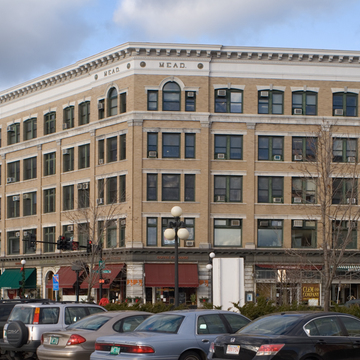In February 1906 a disastrous fire consumed the Bates House and five commercial blocks at the main intersection in downtown Rutland. To jumpstart recovery, John A. Mead acquired three lots at the oblique corner and hired local architect Paige to design a modern four-story commercial block to fill them. A pillar of the community, Mead was a descen dant of Rutland's first settler who became director of the Howe Scale Company in 1888, the city's first mayor in 1892, and lieutenant governor and governor of Vermont. Paige designed most of the city's new schools, the new combined town hall and fire station (1901; 52 Washington Street), the Masonic Hall (1901; 51 Washington Street), and many commercial buildings and houses throughout Rutland. Their collaboration produced a cream-brick-clad, classicizing design with an arched entrance and six storefronts in a rusticated base at street level. The block was unified by a heavy pressed-copper entablature above the first story and three pier-and-spandrel stories topped by another, larger pressed-copper entablature with modillions. Once the building was well under construction, local clothier Frank Wilson offered to take out a ten-year lease on a fifth story if one were added, so Mead and Paige obliged, producing a story with paired windows in arched openings and Palladian windows at the corner. As the first large-scale commercial block built in the new century, the Mead Building symbolized the commercial prosperity and resiliency of Vermont's second-largest city. The similarly styled, four-story Tuttle Block, rebuilt next door on Center Street after the fire, was another of Paige's designs.
You are here
Mead Building
If SAH Archipedia has been useful to you, please consider supporting it.
SAH Archipedia tells the story of the United States through its buildings, landscapes, and cities. This freely available resource empowers the public with authoritative knowledge that deepens their understanding and appreciation of the built environment. But the Society of Architectural Historians, which created SAH Archipedia with University of Virginia Press, needs your support to maintain the high-caliber research, writing, photography, cartography, editing, design, and programming that make SAH Archipedia a trusted online resource available to all who value the history of place, heritage tourism, and learning.















